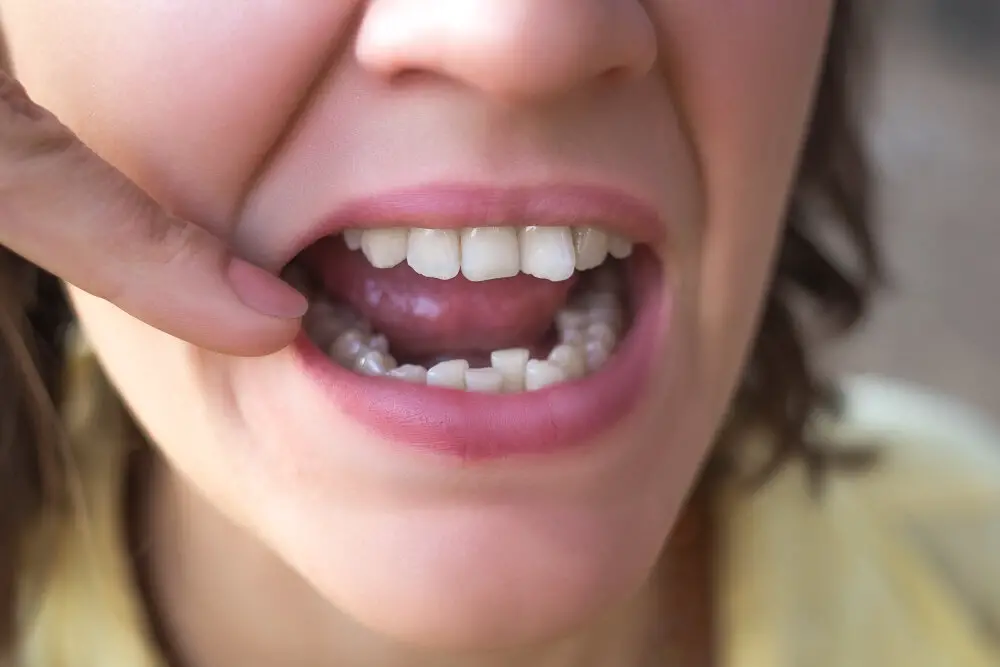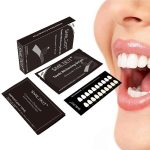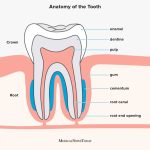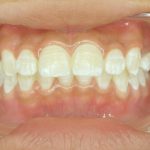Understanding the Cause: Why Do Whitening Strips Cause Tooth Sensitivity?

Tooth sensitivity is a common problem that affects millions of people worldwide, and one of the leading causes of tooth sensitivity is the use of teeth whitening strips. While whitening strips have gained immense popularity over the years as an effective way to brighten one’s smile, they can also cause significant discomfort and sensitivity. Understanding the reasons behind this phenomenon is crucial to help people make informed decisions about their oral health and minimize the likelihood of experiencing tooth sensitivity. Tooth sensitivity caused by whitening strips is a result of the bleaching agents contained in these products. Most whitening strips contain hydrogen peroxide or carbamide peroxide, which are powerful chemicals that penetrate the enamel of the teeth to remove stains and discoloration. However, these chemicals can also irritate the nerves in the dentin layer of the teeth, leading to pain and sensitivity. Additionally, the prolonged use of whitening strips can cause the enamel to thin, making the teeth more vulnerable to sensitivity and other oral health problems. It is essential to understand these underlying causes to make informed decisions about the use of whitening strips and avoid any adverse effects.
Whitening strips are thin, flexible plastic strips that are coated with a bleaching agent, usually hydrogen peroxide. They are designed to be placed on the front surface of teeth for a certain period of time, typically 30 minutes to an hour, to remove surface stains and discoloration caused by food, drinks, and tobacco. Whitening strips have gained popularity in recent years due to their convenience, affordability, and effectiveness in improving the appearance of teeth without the need for professional dental treatment. However, the use of whitening strips can also cause tooth sensitivity, which is a common side effect that can be uncomfortable and unpleasant for some users.
Tooth sensitivity is a common side effect of using whitening strips, and it can be uncomfortable for many people. This sensitivity occurs when the peroxide in the whitening strips penetrates the enamel and reaches the dentin layer, which is filled with microscopic tube-like structures that lead to the nerve endings of the teeth. When the peroxide reaches the dentin, it can cause irritation and inflammation, which leads to tooth sensitivity. This sensitivity can range from mild discomfort to severe pain, and it can last for several hours or even days. It is important to understand the cause of tooth sensitivity when using whitening strips to make sure you are using them safely and effectively.
What Are Whitening Strips Made Of?

Whitening strips are thin, flexible plastic strips that are coated with a layer of peroxide-based gel. This gel contains various ingredients that work together to whiten teeth. The active ingredient in the gel is usually hydrogen peroxide or carbamide peroxide. These chemicals penetrate the enamel of the teeth and break down the stains on the surface, resulting in a brighter, whiter smile. Other ingredients in the gel may include glycerin, water, sodium hydroxide, and carbomer. These ingredients help to keep the gel in place on the teeth and provide a smooth, even application. The plastic strips themselves are made of a material that is safe for oral use and does not react with the peroxide gel. Typically, they are made of polyethylene or polyvinyl acetate. These materials are flexible and moldable, allowing the strips to conform to the shape of the teeth for maximum coverage. The strips are also thin enough to be comfortable to wear and to allow for easy breathing and speaking while they are in place. Overall, whitening strips are a safe and effective way to whiten teeth at home, but they can cause sensitivity in some people, which is important to understand before using them.
Whitening strips are composed of various chemical ingredients that work together to remove surface stains from teeth. The most common active ingredient found in these strips is hydrogen peroxide, which helps break down the stains and penetrate the enamel to whiten the teeth. Carbamide peroxide is another active ingredient, which breaks down into hydrogen peroxide and urea, allowing for a slower release of the whitening agent. Other ingredients found in whitening strips include glycerin, which helps keep the strips in place and prevents dehydration of the teeth, and sodium hydroxide, which adjusts the pH level to promote whitening. While these ingredients are effective in removing stains, they can also cause tooth sensitivity in some individuals, as they can penetrate the enamel and irritate the nerves within the tooth.
The ingredients found in teeth whitening products work to whiten teeth by removing surface stains and penetrating the enamel to remove deeper discoloration. Hydrogen peroxide and carbamide peroxide are commonly used in whitening strips and gels because they break down into oxygen molecules that penetrate the enamel and break apart the chemical bonds that cause stains. However, this process can also cause tooth sensitivity as the peroxide can penetrate the enamel and irritate the nerves inside the tooth. To combat this, many whitening products contain ingredients like potassium nitrate or fluoride that work to desensitize teeth and protect against sensitivity.
Tooth sensitivity is a common problem that occurs when the enamel on teeth is worn down, exposing the underlying dentin and nerve endings. Whitening strips, which contain ingredients such as hydrogen peroxide and carbamide peroxide, can cause tooth sensitivity by penetrating the enamel and oxidizing the pigments that cause discoloration. As a result, the enamel becomes porous and more susceptible to external stimuli, such as hot or cold temperatures, acidic foods and beverages, and even brushing too hard. This can cause discomfort and pain, especially when consuming hot or cold foods and drinks, which can be very unpleasant. It is therefore important to use whitening strips in moderation and to follow the instructions carefully to minimize the risk of tooth sensitivity.
How Do Whitening Strips Cause Tooth Sensitivity?

Whitening strips are a popular at-home teeth whitening treatment that can provide noticeable results in a short amount of time. However, one of the most common side effects of using these strips is tooth sensitivity. This sensitivity occurs because the active ingredient in whitening strips, hydrogen peroxide, can penetrate the enamel of the teeth and reach the sensitive layer of dentin underneath. This exposure can cause temporary or permanent damage to the dentin, leading to sensitivity and discomfort. Furthermore, the duration of the whitening strips application can also contribute to the severity of tooth sensitivity. If the strips are left on for longer than the recommended time, the hydrogen peroxide can penetrate deeper into the teeth, causing more damage and sensitivity. Additionally, using whitening strips too frequently can also worsen tooth sensitivity. It is important to follow the instructions on the packaging and consult with a dentist to determine the appropriate frequency and duration of use for your teeth.
Whitening strips are a popular over-the-counter teeth whitening product that helps to remove surface stains from the teeth. These strips are coated with a gel that contains hydrogen peroxide or carbamide peroxide, which are active ingredients that penetrate the tooth enamel. When the strips are applied to the teeth, the peroxide gel is activated, and it starts to break down the stains on the surface of the enamel. As the peroxide penetrates the enamel, it oxidizes the pigmented molecules that cause the stains, making them lighter and less visible. However, this process can also cause tooth sensitivity, as the peroxide can irritate the nerves in the teeth, leading to discomfort and pain.
The process of using whitening strips can cause microscopic damage to the tooth enamel due to the active ingredients present in the strips. Hydrogen peroxide and carbamide peroxide, which are commonly used in these strips, penetrate the outer layer of the enamel to reach the internal layers of the tooth, where they react with the pigments that cause discoloration. This reaction generates free radicals, which can cause damage to the enamel and dentin. The damage is usually microscopic and not visible to the naked eye, but it can cause tooth sensitivity and other problems if left untreated. In addition to the active ingredients, the frequency and duration of use can also play a role in the extent of the damage caused. Therefore, it is important to use whitening strips as directed and to consult a dentist if you experience any discomfort or sensitivity.
Tooth enamel is the hard, outer layer of a tooth that protects the underlying dentin and pulp. When the enamel becomes damaged, it can lead to tooth sensitivity. This is because the enamel is responsible for blocking the tubules that lead to the nerves in the dentin. When the enamel wears away, the tubules become exposed, and stimuli such as hot, cold, or sweet food can irritate the nerves, causing sensitivity. Additionally, when tooth enamel is damaged, it can make teeth more susceptible to decay and erosion, which can further exacerbate sensitivity. Therefore, it is essential to take good care of tooth enamel to prevent sensitivity and maintain overall dental health.
Who Is Most Likely to Experience Tooth Sensitivity from Whitening Strips?

Tooth sensitivity is a common side effect of using teeth whitening strips, and some people are more likely to experience it than others. Those who have thin enamel or exposed tooth roots are particularly vulnerable to tooth sensitivity. Enamel is the protective layer that covers the teeth, and it can wear down over time due to factors such as brushing too hard or consuming acidic foods and drinks. When the enamel is thin, the underlying dentin layer is more exposed, which can lead to sensitivity. Similarly, when the gums recede, the tooth roots become exposed, which can also cause sensitivity. People who have gum disease or who have undergone gum surgery may be more likely to experience tooth sensitivity from whitening strips. Another factor that can contribute to tooth sensitivity from whitening strips is the concentration of the whitening agent. Most whitening strips contain either hydrogen peroxide or carbamide peroxide, which work by penetrating the enamel and breaking down stains. However, if the concentration of the whitening agent is too high, it can irritate the nerves in the teeth and cause sensitivity. Additionally, leaving the strips on for longer than recommended can also increase the risk of sensitivity. People who are prone to tooth sensitivity may want to choose a lower concentration of whitening agent or use the strips for a shorter amount of time.
There are several factors that can contribute to an increased likelihood of tooth sensitivity from whitening strips. Firstly, the strength of the whitening agent used in the strips can play a significant role in tooth sensitivity. If the whitening agent is too strong, it can penetrate deep into the tooth and cause damage to the nerves, resulting in sensitivity. Additionally, individuals with thin or worn enamel may also be more prone to sensitivity as the whitening agent can easily penetrate the enamel and cause irritation to the underlying dentin. Finally, prolonged use of whitening strips or leaving them on for longer than recommended can also increase the risk of tooth sensitivity. It is important to always follow the instructions provided with the product and to consult with a dentist if you experience any discomfort or sensitivity.
The use of teeth whitening strips can cause tooth sensitivity, and several factors can contribute to its occurrence. Age is one factor as the enamel of the teeth becomes thinner as we age, making it easier for the whitening chemicals to penetrate and irritate the nerves. Preexisting dental issues like gum disease, cavities, and enamel erosion can also increase tooth sensitivity when using whitening strips. Lastly, the frequency of use is also a contributing factor as frequent application of whitening strips can cause the teeth to become overly sensitive. Understanding these factors is crucial in determining the appropriate use of teeth whitening strips and preventing potential discomfort or pain.
How Can You Reduce Tooth Sensitivity from Whitening Strips?

Tooth sensitivity is a common side effect of using whitening strips. The good news is that there are several ways to reduce tooth sensitivity caused by these strips. Firstly, it is important to follow the instructions on the packaging carefully. Overuse of the strips can cause more sensitivity. Using them for the recommended amount of time and frequency can help to minimize the sensitivity. Additionally, using a toothpaste formulated for sensitive teeth can be helpful. These toothpastes contain ingredients that help to soothe and protect sensitive teeth. Using a soft-bristled toothbrush can also help to reduce sensitivity by being gentle on the teeth and gums. Another way to reduce sensitivity is to take a break from using the whitening strips. This can give the teeth time to recover and reduce sensitivity. It is also important to avoid foods and drinks that can cause sensitivity, such as hot or cold drinks and acidic foods. Rinsing the mouth with water after consuming these items can help to reduce sensitivity. Finally, visiting a dentist can help to determine the cause of the sensitivity and provide additional treatment options. Overall, reducing tooth sensitivity from whitening strips involves being gentle on the teeth, using the strips as directed, taking breaks, and avoiding foods and drinks that can cause sensitivity.
To reduce tooth sensitivity from whitening strips, there are several steps that can be taken. Firstly, it’s important to use the strips as directed and not leave them on for longer than recommended. This can help prevent overexposure of the teeth to the whitening agent, which can cause sensitivity. Secondly, using a toothpaste specifically designed for sensitive teeth can help alleviate discomfort. Additionally, avoiding acidic foods and drinks can help reduce sensitivity. Finally, taking breaks between whitening sessions can give the teeth time to recover and reduce sensitivity. By following these steps, individuals can enjoy the benefits of whitening strips while minimizing any discomfort.
For individuals with sensitive teeth, the use of whitening strips can be a painful experience. Fortunately, there are alternatives available to achieve a brighter smile without causing discomfort. One option is to use whitening toothpaste, which contains a mild abrasive that gently removes surface stains. Another alternative is to visit a dentist for professional teeth whitening, which uses a stronger bleaching agent but is done under controlled conditions to minimize sensitivity. Additionally, using natural remedies like oil pulling or baking soda can also help whiten teeth without causing sensitivity. Overall, it’s important to explore these alternatives and choose the method that best suits your individual needs and sensitivity level.
To ensure safe and effective use of whitening strips, it is important to read and follow the instructions carefully. Whitening strips should only be used for the recommended amount of time, as overuse can cause tooth sensitivity and damage to the enamel. It is also important to avoid using whitening strips on damaged or sensitive teeth, and to consult with a dentist before using them if you have any dental issues. Additionally, it is recommended to avoid consuming staining foods and drinks, such as coffee and red wine, during and after using whitening strips to maintain the desired results. Proper oral hygiene, including brushing and flossing regularly, can also help prevent tooth sensitivity and maintain a healthy smile.
Tooth sensitivity is a common side effect of using whitening strips. This occurs when the peroxide in the strips penetrates the enamel and reaches the dentin, which contains microscopic tubules leading to the nerve endings. When these tubules are exposed to the peroxide, it can cause irritation and inflammation, leading to tooth sensitivity. Other factors that contribute to tooth sensitivity from whitening strips include using strips that are too strong or leaving them on for too long. In some cases, pre-existing dental conditions such as gum recession or enamel erosion can also increase the likelihood of experiencing sensitivity with whitening strips.
Tooth sensitivity can be a frustrating and uncomfortable condition, but fortunately, there are steps that can be taken to reduce its impact. Firstly, it is important to maintain good oral hygiene habits, such as brushing twice daily with a soft-bristled toothbrush, flossing daily, and using a fluoride toothpaste. Secondly, avoid consuming highly acidic foods and beverages, which can erode tooth enamel and contribute to sensitivity. Additionally, reducing the frequency of teeth whitening treatments or opting for a lower strength formula can also help alleviate sensitivity. Finally, utilizing desensitizing toothpaste or undergoing professional treatments such as fluoride varnish or dental bonding can provide further relief for sensitive teeth. By implementing these measures, individuals can take control of their tooth sensitivity and improve their overall oral health.
In conclusion, while whitening strips are generally safe and effective for tooth whitening, they can also cause tooth sensitivity in some individuals. It is important to follow the instructions carefully, use the strips for the recommended time and frequency, and avoid overuse. It is also advisable to consult with a dentist before using whitening strips, especially if you have pre-existing dental conditions or sensitivity issues. Overall, the benefits of using whitening strips for a brighter, whiter smile can be achieved with proper caution and care.
Conclusion

In conclusion, understanding the cause behind tooth sensitivity caused by whitening strips is crucial in preventing further damage to our teeth. The chemical composition of the strips and the way they interact with the tooth enamel can cause nerve irritation and discomfort. It is important to follow the instructions carefully and not overuse the product to avoid damaging the enamel further. Moreover, choosing the right product and consulting with a dentist can help prevent tooth sensitivity and achieve a brighter smile without any risks. Overall, being mindful of the potential risks and taking the necessary precautions can help us maintain healthy and pain-free teeth.







